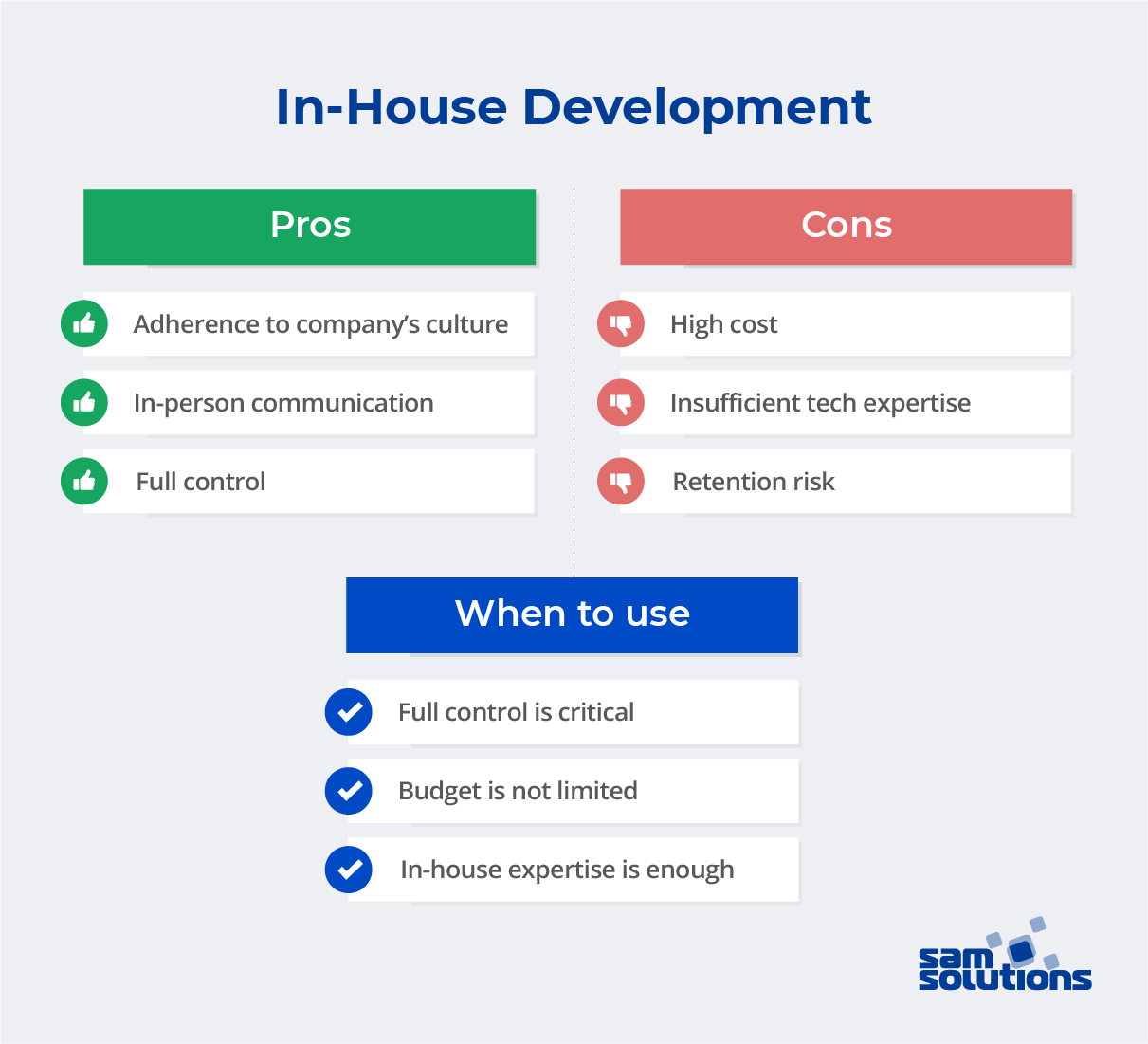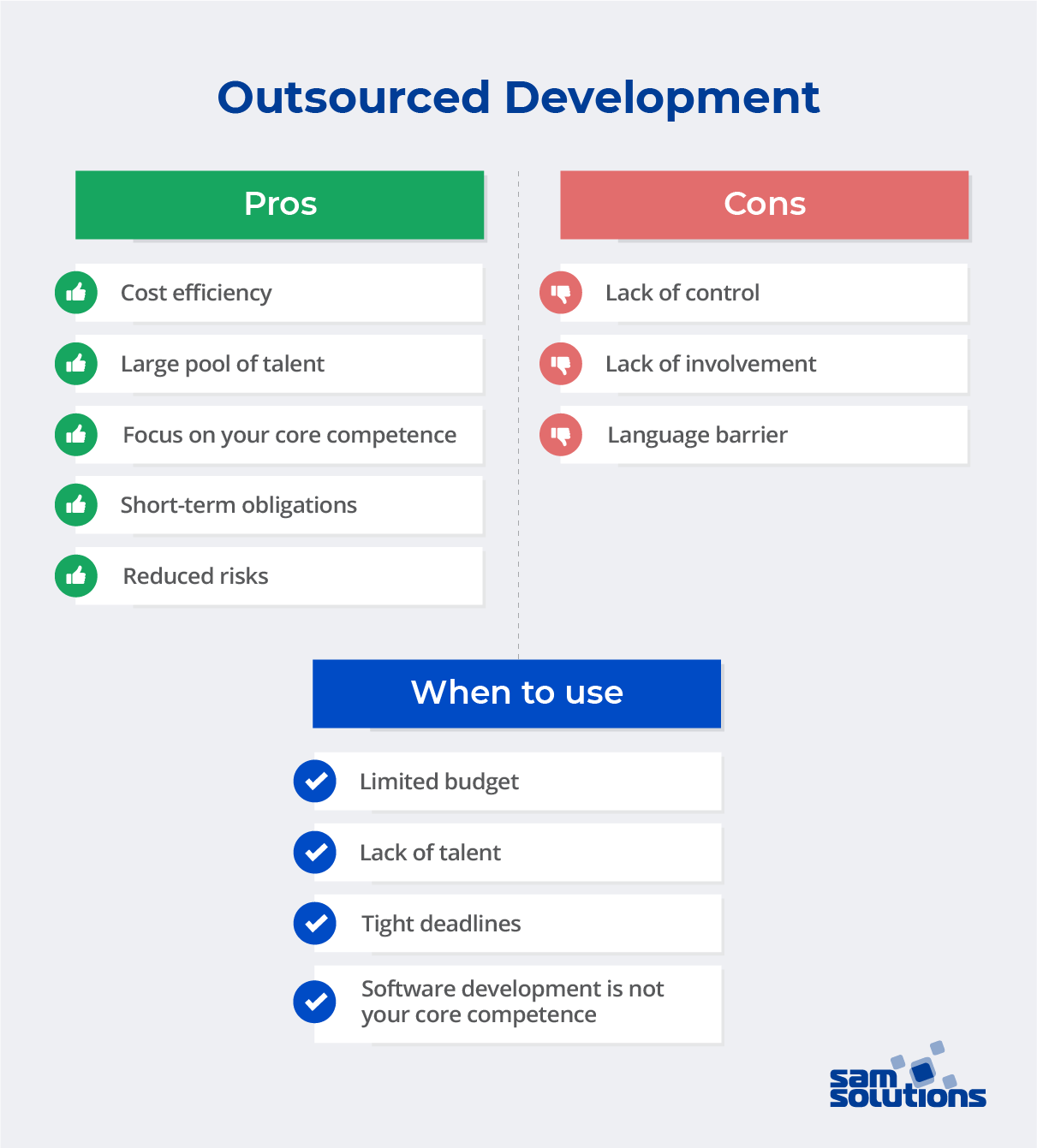To outsource, or not to outsource, that is the question. Actually, this question may torment business owners who need to implement some software development tasks but don’t know how to make the right choice between in-house development and outsourcing.
Let’s discuss the peculiarities of the two models: in-house software development and outsourcing services. As soon as you understand their essence, advantages and disadvantages, you’ll be able to analyze your business situation and decide on the most appropriate model for your project development.
Overview
Let’s start with defining the terms.
What is outsourcing?
Outsourcing is the delegation of programming tasks to hired organizations (contractors) with the appropriate expertise and the permanent staff of specialists who possess tech skills required for your project. You can engage a team of developers either locally (onshoring), or in a neighboring country with no significant time zone differences (nearshoring), or in any country regardless of its geographical location and time zone (offshoring). These are the three service delivery models of outsourcing.
Develop your custom software with SaM Solutions’ engineers, skilled in the latest tech and well-versed in multiple industries.
There are also three outsourcing models regarding the type of development team you can choose:
- Full-process outsourcing (aka project-based) — the vendor takes responsibility for the entire development process.
- Dedicated team (aka managed team) — the vendor’s team cooperates with the client’s team, but without full integration.
- Staff augmentation (aka extended workbench) — the vendor provides some specialists to complement the existing client’s team.
And finally, you can choose the pricing model if you turn to outsourcing:
- Fixed price — the budget is determined before launching the project based on the clearly defined requirements and the scope of work.
- Time and materials (T&M) — the client pays for the actual resources spent.
- Dedicated team fee — the client is charged a monthly fee for each employee, which is composed of their salary, taxes, benefits package, infrastructure expenses and company’s profit margin.
What is in-house development?
In-house development or insourcing refers to the creation of software within your company, using your own resources and without involving third-party employees. The work is performed by full-time developers with a fixed salary and other employment benefits and under your direct control. In-house software development also requires setting up an office or infrastructure with all the required amenities, hardware and software tools.
If you don’t have specialists needed for the project, but still don’t want to outsource them, you should organize the recruiting process, hire them to your staff and build the team from scratch.
Now that you have a solid understanding of the two concepts, let’s start comparing in-house development vs. outsourcing by looking at their pros and cons.
In-House Development

Pros
- Adherence to company’s culture. When your permanent employees participate in the project’s creation, they are more involved in the process than third-party specialists. This happens because they are already tightly integrated into the company, share its corporate values and know all the peculiarities and needs of the company. As a result, they are more motivated to achieve a common goal, which adds value to their work.
- Full control. When you choose the insourcing approach, you should understand that you are the boss. You gain control over the team and the development process, which may be essential for some projects. Supervising the implementation of tasks, tracking the progress and making adjustments at any moment — these are some positives of this approach.
- In-person communication. The ability to communicate face to face is a significant advantage for any project involving teamwork. With in-house development, the entire team works together in the same office and in the same time zone. Hence, they can reduce misunderstandings and make changes faster, speeding up time to market.
Cons
Assembling the team from your in-house employees, of course, has the right to exist. But before selecting such a model, keep in mind that, as experience has shown, business owners may face a range of disadvantages working with full-time specialists. Let’s take a look at them.
- High cost. The cost of internal software development services is significantly higher than that of hiring a vendor’s developers. This is because you have to cover not only salaries and taxes but also hidden expenses that include recruitment, benefits package, overheads, infrastructure costs, etc. Remember that your employees remain on board even when the project is over, so you have to provide constant work for them and pay fixed salaries even between projects.
- Insufficient tech expertise. If software engineering is not your key business function, apparently you lack tech talents with cutting-edge skills and hands-on experience. Hence, you won’t be able to create a complicated software product on your own.
- Retention risk. Most software developers strive for learning and acquiring new skills. If there are no interesting software development projects within your company where specialists can apply and upgrade their skills, it’s a challenging task to retain them. Software specialists are highly demanded in the labor market, so you risk losing your best talents. The worst thing is that it may happen when the project is not over, and you’ll need to look for new team members amid the development process. This option is costly, counterproductive and time-consuming.
When to use in-house development
Despite the disadvantages we described above, there are certain situations when in-house development is more suitable. These are the following situations.
- Full control is critical. Sometimes business owner want to have total control over the product creation, e.g., if the work relates to critical data or corporate secrets. In this case, insourcing is the best choice, as you can personally track the progress on a daily basis, solve issues immediately and monitor to ensure that no information goes outside the company.
- Budget is not limited. If you have enough resources at your disposal and the budget is not constrained, you can easily hire an in-house team and enjoy the advantages it provides.
- In-house expertise is enough. In case you already have all the necessary team members on staff to implement your project, there is no need to reinvent the wheel.
Outsourced Development

Outsourcing is one of the most controversial topics of the last two decades. Companies around the world are using this development strategy to grow their business by reducing operational costs and improving service quality.
But while some entrepreneurs are praising the benefits of outsourcing, others are sharing their bad experiences with outsourcing companies. Such a contrast can be confusing, and very often prevents them from making the right decision. Let’s see what pros and cons of outsourcing services exist.
Pros
- Cost efficiency. This is a critical factor to consider when comparing in-house development with outsourcing. For most companies, outsourcing is as a tool to reduce costs, including due to lower labor rates: according to various statistics, the average software developer salary in western countries ranges from $100 to $150 per hour, while in Eastern Europe it ranges from $20 to $40 per hour. By combining the cost of infrastructure, hiring, and developer hourly rates, you can cut project development costs by up to 60% through outsourcing. Consequently, outsourcing not only saves you time, but also a huge amount of money that you can use for other important tasks to grow your business.
- Large pool of talent. To create a software solution, website or mobile application, you may generally need a team comprised of developers with required skills (e.g, embedded software development), designers, QA testers, and a project manager. If you search and hire such specialists on your own, it will cost you a fortune, and you’ll waste much time. An outsourcing company has a large pool of talent with various tech skills (backend and frontend development, Java, React, .NET, etc.), so you can quickly assemble a team you need.
- Focus on your core competence. Contractors perform tasks that are not your core business functions. For example, if you are the owner of a logistics company, you want to pay more attention to goods and their transportation rather than mobile app development for your drivers or creating a GPS tracking system. This pattern is very clear in large companies. Delegating non-core tasks to contractors reduces the burden on the internal team and therefore increases overall work productivity. By following this approach, you are actually accelerating the growth of your business.
- Reduced risks. There are several types of risks associated with a software development project: timing, budget, operational, technical, external risks. Outsourcing is always regulated by a legal contract, which significantly reduces risk for the client. It includes important aspects such as the scope of work, payment, deadline, performance, NDA (non-disclosure agreement), the terms of the withdrawal from the project and others.
- Short-term obligations. Being able to involve experts without long-term obligations is a big advantage. In case of outsourcing, you hire developers for a certain project, pay for the work done (according to one of pricing models described above), and part with them as soon as the project is over . Whereas, hiring an in-house team is a long-term commitment that comes with a fixed monthly salary and other employee benefits. Given that the project will only last for two months, it makes no sense to hire a new developer to your team on a permanent basis.
Cons
- Lack of control. Perhaps the most common problem with outsourcing is that a client has limited control over the development process. This happens because the client and the team may be geographically far away from each other and their daily working schedules may not coincide due to different time zones, which results in communication gaps, misunderstandings and postponed adjustments. But you can avoid this issue by documenting all your requirements, creating milestones and a project charter, and agreeing on the meeting times and communication channels in advance. This way you can keep track of the progress and easily figure out if something goes wrong.
- Lack of involvement. Another issue is an incomplete involvement of team members into your project. It’s not a secret that developers in outsourcing companies work on various projects. Hence, they can be distracted and can’t fully devote themselves to your single project.
- Language barrier. When you hire an offshore team, you may bump up against a language barrier. However, trusted outsourcing companies strive to ensure the suitable language level of their employees, so that clients don’t suffer from this issue.
When to use outsourcing development
You should outsource your software development tasks in the following situations.
- Limited budget. If you don’t have extra money to spend on recruitment and retention of developers, building your own infrastructure or covering possible risks, outsourcing is your choice.
- Lack of talents. If there are no in-house specialists you need for the project, you’d better turn to an outsourcing company.
- Tight deadlines. If the delay of your project release is unacceptable, you should definitely rely on outsourcing.
- Software development is not your core competence. If your priority is to focus on core business functions, outsource all the other tasks — this is the best formula for success.
Why are some companies doubtful about outsourcing?
There are several reasons why companies may be cautious about outsourcing, despite all its advantages.
- Negative previous experience. It is true that not all outsourcing providers diligently perform their duties. So if you didn’t get the expected result or even suffered losses once, you’ll be doubtful about turning to an outsourcing company again.
- Fear of losing critical information. Companies that need to create software products on the basis of critical information or some innovative insights are not wiling to involve third-party people in the processes. In order to prevent data leakage, they are more likely to choose in-house development.
In-House Development vs. Outsourcing
The table below provides a quick comparison of outsourced and in-house development on the six main aspects: cost, time to market, communication, control, pool of talent, tech expertise.
| IN-HOUSE DEVELOPMENT | VS. | OUTSOURCING |
| higher | cost | lower |
| slower | time to market | faster |
| direct | communication | indirect |
| full | control | limited |
| limited | pool of talent | wide |
| poor | tech expertise | diverse |
Conclusion
The advantages of working with an offshore team, including cost efficiency and quicker development time, incline more and more business owners to outsourcing. However, in-house development seems like a good idea for those who need full control over their product creation. Our general advice on how to select the best development model is to assess your specific situation from various aspects.
Remember that outsourcing takes over most of the software development planning and execution, freeing up your efforts to focus on more business-critical tasks.
If you’ve decided that cooperation with an outsourcing company would be the best solution for you, we are ready to consider your request and discuss the details of the project. Get in touch with SaM Solutions.



























 5 Reasons Why Your Business Needs a Mobile eCommerce Application
5 Reasons Why Your Business Needs a Mobile eCommerce Application Using Salesforce to Improve Your Sales Pipeline: Five Tips
Using Salesforce to Improve Your Sales Pipeline: Five Tips Cross-Platform Mobile Development: Five Best Frameworks
Cross-Platform Mobile Development: Five Best Frameworks How to Develop Custom Accounting Software
How to Develop Custom Accounting Software 10 Best Web Development Frameworks in 2024
10 Best Web Development Frameworks in 2024












 Top 30 Ecommerce Tools to Elevate Your Business in 2024
Top 30 Ecommerce Tools to Elevate Your Business in 2024 5 Best Tools to Improve Embedded Software Testing
5 Best Tools to Improve Embedded Software Testing Why React and Node.js Are the Top Technologies for Creating High-Performance Web Apps in 2024
Why React and Node.js Are the Top Technologies for Creating High-Performance Web Apps in 2024 10 Best IoT Platforms for 2024
10 Best IoT Platforms for 2024
Do the tasks you can do well, and outsource all the other tasks. I guess this is the right advice on the topic. People spend years and much effort to become specialists in a particular domain, so turn to such people instead of trying to reach their level within a month.
I like in-house development for the privacy and direct communication during the entire process, which can be crucial for certain projects. While outsourcing services are advantageous for many companies who need to have the work done quicker.
Developers working for outsourcing software providers usually have more extensive experience. Hence outsourcing grants access to the best pool of talents, and this is the main benefit of this model.
Sometimes it’s really hard to choose between in-house development and outsourcing. Both models have their pros and cons, so the choice should be based on a particular situation and conditions.
Some outsourcing providers are not reliable, that’s true. I’d like to read a guide with tips on how to choose a software development company and not be disappointed.
Software development outsourcing is a flourishing sector of the market, because most companies prefer delegating tasks they can perform well to third-party contractors. It’s a wise approach, I believe.
In-house development is good when you already have a team of experienced developers and other specialists. But when you need to build it from scratch, this can become a true headache for the company.
I’m sure that nowadays outsourcing is the most efficient way to grow your business and achieve great results quicker. The thing is that you should responsibly approach the choice of a software development provider.